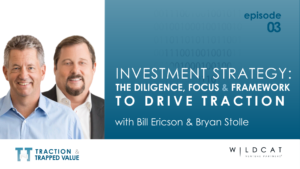Ep. 3 - Investment Strategy: The Diligence, Focus and Framework to Drive Traction.
September 16, 2020
PUBLISHED BY Wildcat Venture Partners

With rapidly increasing fund sizes and record-breaking dry powder in venture, putting early stage capital to work efficiently is challenging.
And as we learned from Bill Ericson in Episode 1 and Episode 2 regarding the ‘Evolution of Venture Capital’, bigger funds and checks aren’t better when it comes to driving outsized returns – in fact, they can be quite detrimental.
In venture, you want to encourage capital-efficient business models early on, and only apply larger amounts of capital once the companies are scaling rapidly. That’s when they can then effectively use these funds.
If you stay focused on true early stage investing, the capital required to help a company reach the point where it’s ready to scale should be limited. However, many of the large investors who have entered the early stage market are unable to take advantage of this dynamic. In fact, they are often forced to deploy more capital than young companies require — which can encourage inefficiency, mask serious business model flaws, and ultimately compress returns.
Discipline and Managing the J-curve
Applying discipline to your investment strategy — and in particular, portfolio construction — is critical to driving returns. In a venture portfolio, the goal is to diversify the portfolio enough to maximize one’s chances of being an early investor in a major winner, while maintaining large enough ownership in each company such that a substantial win can return a multiple on the fund’s value.
In venture today, losing substantial amounts of money early in the fund’s life – the J-curve phenomenon- has become less acceptable. So it’s important to build a portfolio that allows you to manage that dynamic and flatten the curve as much as possible. This can be challenging because you generally don’t get quick wins in early stage portfolio.
Bryan Stolle, General Partner at Wildcat, says their approach to managing the J-curve is initially allocating a portion of the portfolio to companies that will mature faster — generally a handful of “category leaders” that are entering the go-to-scale phase. These investments serve to balance out the earlier-stage companies that will take more time to develop. Wildcat can then recycle the dollars from early liquidity events back into the portfolio before the end of the fund’s life, doubling down on winners and providing additional diversification. This recycling can also increase the portion of committed capital that ends up being invested, which offsets the impacts of management fees and drives a higher net multiple for LPs.
Going Deep vs. Broad
Wildcat believes in layering several key investment practices to create a sound strategy that can deliver repeatable, high returns.
These practices not only include a targeted portfolio construction based on investment stage, but also a clear focus on specific business models and vertical opportunities. Wildcat prefers B2B and B2B2C companies that have inherently capital-efficient business models, attractive recurring revenue, and low customer churn.
Thesis areas are also critically important because they are a forcing function for thinking deeply about the areas you’re investing in. Bill’s belief is that the only way to be a really great venture investor — that is to know what to invest in and what not to invest in — is to be deep in the subject matter of the investment and thus, thesis areas.
Thesis areas enable Wildcat to identify and invest in companies and categories [at the very earliest innovation opportunity because the category winner typically accrues the greatest market share.
That’s contrary to investing in ‘what’s hot.’ At that point clear signals have already emerged that there’s a fundamental innovation or transformation that is taking hold in an industry, subsequently drawing attention from the broader investor marketplace. The truth is focusing on a hot sector implies you’re more of a follower than a market innovator.
Diligence and Finding Trapped Value – It’s About the People
In early stage as Bryan outlines, “there is no business to look at. There are no financials really to look at that are meaningful. It’s really all about understanding the market opportunity, understanding the entrepreneur, the team.”
So it is critical to go in and diligence where the open opportunities are in a particular industry or set of business processes. Who knows about them? Who are the likely buyers, who are the likely buyers of the product, and if it’s successful, of the company itself? Many of these questions can be answered through one’s network.
Connections and relationships can not only help you find investments and identify market opportunities but even more importantly, they can help you diligence the people behind a company.
The reality is people — the entrepreneurs — are behind everything that happens in a startup, and that’s the way Wildcat thinks about the businesses they invest in. The people will reduce the technical risk. They will figure out the right go to market strategy. They will convince customers who may be reluctant that they should give them a shot.
So, while it’s easy and common to look at these things clinically, the reality is that it’s about the entrepreneurs. Evaluating them requires an entirely different skillset based on years of experience and deep connections within the thesis areas you’re targeting.
Traction and Trapped Value is produced by Flywheel Associates
KEYWORDS